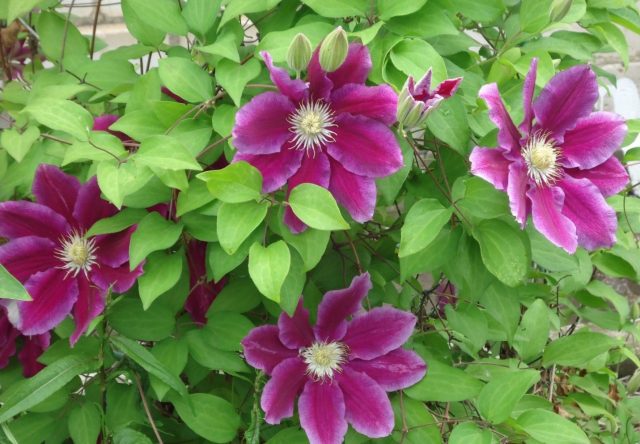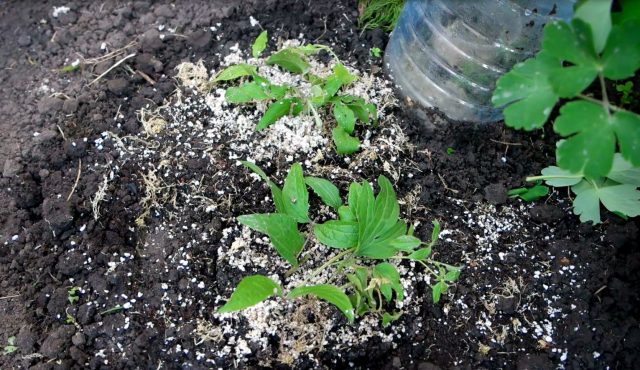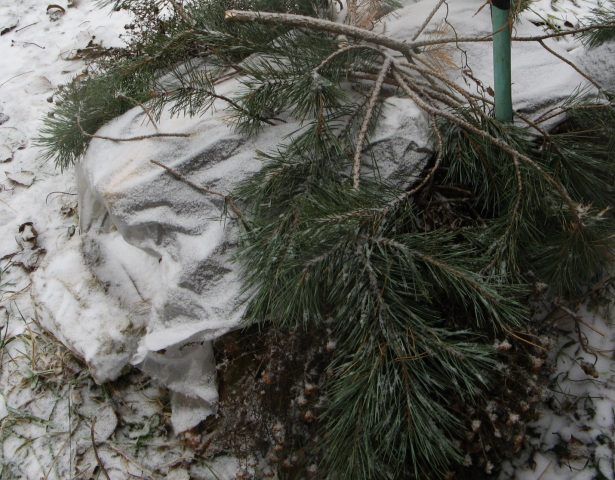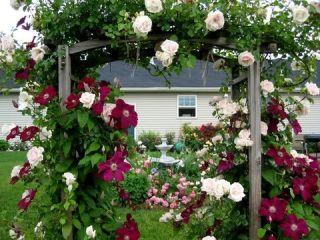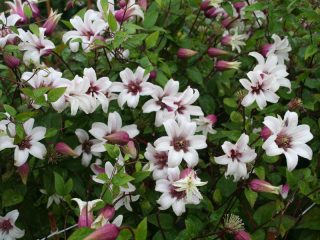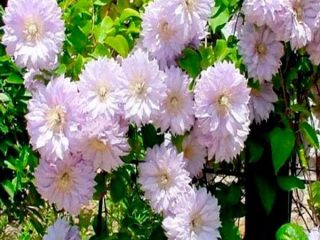Content
Every year the number of varieties and forms of clematis is steadily increasing. The popularity of these flowers can hardly be overestimated. Clematis Hania is of particular interest. This amazing plant from a small seedling turns into a living wall of many bright flowers. The decorative value of clematis lies in its flowers. Therefore, proper maintenance and pruning are especially important to obtain abundant flowering.
Description of clematis Hania
This variety was bred by Polish breeders. Chania flowers are quite large, velvety. The color is two-tone: sparkling red petals are framed by a pinkish border. Golden stamens create an unusual contrast. The flowering period lasts from late May to August. In July, the plant takes a short break. The height of the bushes reaches from 2 to 2.5 m. This variety does not tolerate intense heat and open sun.
Clematis hybrid Hania will become a real decoration of the garden plot. It is best to plant it near pergolas, arbors. Skillful use of garden supports and trellises can create a beautiful hedge.
Clematis pruning group Hania
The pruning procedure plays an important role in the life cycle of Hania clematis. All known species and varieties are divided into three different groups. Chania belongs to the second. This group contains the most beautiful clematis. The most abundant flowering will be on the shoots of the last year (June). Flowering will not be so intense in the second half of summer. With the arrival of autumn, the shoots are cut to 1-1.5 m.
Planting and caring for clematis Hania
Judging by the photos and descriptions of clematis Hania, of which there are many on flower-growing forums, it is best to choose seedlings in specialized gardening centers. It is necessary to store the planting material at a temperature from 0 to + 2 ° С. If the buds begin to sprout, the Chania seedling is transferred to a cool place with bright diffused light. This will prevent the shoots from stretching.
It is possible to plant clematis Chania in open ground only at a stable above-zero temperature. Night frosts will destroy the young plant. The choice of a place must be taken seriously, because the vine will grow on it for the next 10-15 years. For planting clematis, the eastern, western or northern side of the site are suitable. The main thing is that there are no strong winds and drafts. To protect the long root of Chania from contact with groundwater, you need to make a small embankment. The soil should be fertile and loose enough to allow moisture and oxygen to pass through well.
The technology of planting clematis Hania is as follows:
- Find a site that meets all the requirements.
- Measure the optimal distance from clematis to other plants (approximately 50-70 cm).
- Place the tub with clematis in water for a while (15-20 minutes is enough). The substrate should be well saturated with water.
- Dig a hole 60x60x60 cm in size. Mix the top fertile soil layer with humus or compost (1.5-2 buckets). If the ground is hard, add sand. Light soil should not be additionally loosened. Mix the prepared soil with mineral fertilizers (superphosphate + wood ash + chalk and dolomite flour). Clematis Hania prefer neutral to slightly alkaline soils. Acidic fertilizers are not suitable for them, so it is better to refuse potassium sulfate. Mix all ingredients thoroughly.
- Fill the bottom of the pit with drainage (pebbles or gravel), then there is a little humus or compost. The last layer is a fertilized substrate. The mixture must be poured with water so that it shrinks. There should be a gap of 15 cm between the top layer of the earth and the edge of the pit.
- The depth of the seedling depends on the type of soil. On light sandy stones, the depth reaches 5-10 cm, and on heavier soils - 3-5 cm is enough. The earth around the seedling needs to be tamped a little, watered abundantly and mulched.
Further care for clematis large-flowered Chania is simple. It requires the same activities as all other plants. First of all, this is watering. The plant is moisture-loving. It must be watered abundantly once a week. In the hot period, hydration is increased up to 2-3 times a week. One young bush takes about 1-2 buckets of water, an adult clematis needs more water - 2-4 buckets at a time. Often, several pots with holes in the bottoms are dug in around the bushes of Chania. When watering, water accumulates in them, then it gradually penetrates into the ground, feeding the roots in dry and sultry weather. If in the spring the soil around clematis was mulched, it is not necessary to loosen it. If not, you will have to carry out the loosening procedure after each watering.
Regarding top dressing, then in the first year you should not fertilize a young Hania seedling, the risk of decay is too high. It is recommended to make fertilizing during the period of active growth. Emphasis is placed on nitrogen-containing mixtures. When forming buds, potash fertilizers are used, after flowering, phosphorus-based preparations. After summer pruning, a complex mineral fertilizer is applied at the rate of 20 g / 10 l of water. In spring, the plant will support the milk of lime (chalk + dolomite flour).
Correctly cutting and pinching them in the summer, you can adjust the flowering time. After shortening the strong shoots on the growing branches, the flowers will appear later, but the flowering will be lush and long.
Preparing for winter
The Clematis Hania need shelter. After the first frosts in the varieties of the second group, shoots are cut off by 1/3 of the length. The vines are carefully rolled up in rings and laid on the ground. From above they are covered with sawdust, dry earth, humus or peat. One bush will need about 1-2 buckets. Under such a shelter, Clematis Hania is able to survive without loss a drop in temperature down to -35 ° C.
Reproduction
Breeding clematis Hania is an easy task. This is done in several ways:
- Seeds... Reproduction of clematis Chania seeds is carried out most often. They are sown in March or April. For 10 days, the planting material is soaked in water (it is replaced several times a day). Then, suitable containers are filled with earth with peat and sand in equal proportions. Spread seeds on top and sprinkle with a layer of soil. Its thickness should be 2 or 3 times greater than the diameter of the seeds. Next, the crops are watered, sealed with foil and placed in a warm, bright place. Further care is the same as for any other seedlings. With this method of reproduction, the flowers lose some of the varietal characteristics.
- By dividing... Green or lignified cuttings are used. They are treated with a solution of stimulants. Cuttings root well in moderately moist peat or sand. The air temperature remains within the range of + 18-22 ° С.
- Layers... The most popular way. In the spring, near an adult bush, grooves are made 10 cm deep. In them, the shoots are tilted and fixed with brackets. Sprinkle with earth and watered abundantly. The next year, the rooted shoots are planted.
Diseases and pests
Over-watering causes fungal infections. Chania bushes often contain powdery mildew, gray rot, rust and brown spot. The most dangerous are fusarium and wilting (wilt). To avoid problems, you need to carry out prophylaxis with fungicides.
Among the dangerous pests of clematis Hania, one can single out the root gall nematode. These are small worms that infect the roots of the bush. The plant will have to be destroyed. Spider mites, aphids and slugs appear on the flowers. A solution of potassium soap, celandine tincture or Fitoverm will help to cope with them. As a preventive measure, you can plant calendula or marigolds near clematis. They repel pests well.
Conclusion
Curly clematis Chania does not require too complicated care. This plant is a real find for any garden. With the help of designs for vines, you can get a pyramid or arch entwined with flowers. Other supports can be used. With Clematis Hania, you can endlessly fantasize, creating a unique landscape design.
Reviews about Clematis Hania
